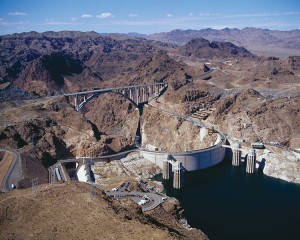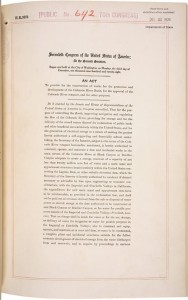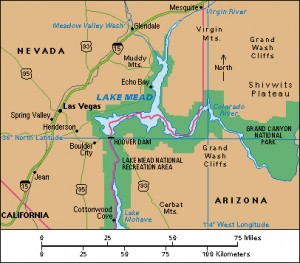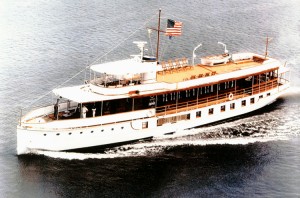Boulder Canyon Project
Wednesday, December 19th, 2018December 19, 2018
On Dec. 21, 1928, 90 years ago this Friday, United States President Calvin Coolidge signed the Boulder Canyon Project Act that authorized the building of the Hoover Dam. The dam, which was named for Coolidge’s successor as president, Herbert Hoover, is one of the highest concrete dams in the world. It stands in the Black Canyon of the Colorado River on the Arizona-Nevada border. The Boulder Canyon Project included the construction of a hydroelectric power plant, a reservoir, and later the Mike O’Callaghan-Pat Tillman Memorial Bridge. The Boulder Canyon Project supplies water and electric power for much of the Pacific Southwest.

The Boulder Canyon Project Act of 1928 authorized the construction of Hoover Dam, one of the world’s highest concrete dams. The Mike O’Callaghan-Pat Tillman Memorial Bridge spans the canyon just south of the dam. Credit: U.S. Department of Transportation
Hoover Dam stands about 25 miles (40 kilometers) southeast of Las Vegas, Nevada. Hundreds of thousands of people visit the dam each year. The dam is 726 feet (221 meters) high and 1,244 feet (379 meters) long. Elevators descend the equivalent of 44 stories into the dam. But they still do not reach its base. The concrete base is 660 feet (200 meters) thick. It contains enough concrete to pave a two-lane highway from New York City to San Francisco. Water falling through the huge turbines of the dam generates electric power. The power is sold to industries and to cities in the Pacific Southwest. The power plant has a capacity of about 2 million kilowatts.

Click to view larger image
The Boulder Canyon Project Act of 1928 authorized the building of the Hoover Dam. The first page of the act is shown here. Credit: National Archives
Lake Mead, the dam reservoir, is one of the world’s largest artificially created bodies of water. It is about 115 miles (185 kilometers) long and 589 feet (180 meters) deep. The reservoir stores approximately 28 million acre-feet (35 billion cubic meters) of water. Water from Lake Mead can irrigate about 1 million acres (400,000 hectares) of farmland in the three-state area. The reservoir also supplies water for cities in southern California.

Click to view larger image
This map shows the location of Lake Mead, a large artificial lake on the Arizona-Nevada border. The lake was created by the completion of Hoover Dam on the Colorado River. Credit: WORLD BOOK map
The need for a dam on the Colorado River was apparent in the early 1900′s. Floods were causing much damage in the Palo Verde Valley and in the Imperial Valley. Extensive levees were built. But crops died when the river ran too low to meet the area’s irrigation needs. In 1928, Congress approved the Boulder Canyon Project. The Bureau of Reclamation designed the dam and supervised its construction. The entire project cost about $385 million. The dam itself cost about $165 million. Hoover Dam was completed in 1935.



